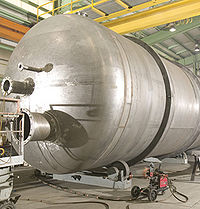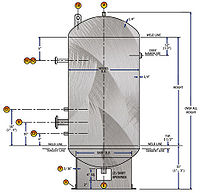Pressure Vessels
Pressure Vessels are commonly Structures such as pipes or bottles capable of holding internal pressure have been very important in the history of science and technology. Although the ancient Romans had developed municipal engineering to a high order in many ways, the very need for their impressive system of large aqueducts for carrying water was due to their not yet having pipes that could maintain internal pressure. Water can flow uphill when driven by the hydraulic pressure of the reservoir at a higher elevation, but without a pressure-containing pipe an aqueduct must be constructed so the water can run downhill all the way from the reservoir to the destination. Airplane cabins are another familiar example of pressure-containing structures. They illustrate very dramatically the importance of proper design, since the atmosphere in the cabin has enough energy associated with its relative pressurization compared to the thin air outside that catastrophic crack growth is a real possibility.
Common Types
Chlorine Contact Tanks
Chlorine Contact Tanks are typically used with chlorine injection equipment in a well water system to help comply with strict new drinking water standards. Chlorination is the most common disinfection method for public and private drinking water systems. This disinfection process is necessary to kill disease-causing bacteria in the water. In order to be sure the added chlorine is killing the bacteria, the water is detained in the vessel for at least 30 minutes. Chlorine Contact Tanks are designed to the working pressure of the existing or new water distribution system. Sizing is based on the site restrictions, available pumping rate, and a minimum required chlorine contact time.
Flash Tanks
Flash Tanks are used in boiler operations to recover and reuse the blowdown heat in a waste heat recovery system. Boiler blowdown wastes energy because the blown down liquid is at about the same temperature as the steam produced, usually above 220 °F. Much of this heat can be recovered by routing the blown down liquid through a Flash Tank in combination with a heat exchanger. Heating boiler makeup water saves on fuel costs. Cooling the blowdown has the additional advantage of helping to comply with local codes limiting the discharge of high-temperature liquids into the sewer system.
Hydropneumatic Tanks
Hydropneumatic Tanks are ASME vessels that contain both water and air under pressure. The compressed air acts as a cushion that can exert or absorb pressure as required. A small air compressor may be used to replenish the air volume periodically as it is absorbed into the water. Large hydropneumatic tanks are usually horizontal and with volumes of 2,000 gallons or more. Normal operating pressure for a water system is 60 to 75 psi., therefore common design pressure for a hydropneumatic tank is 100 psi. They provide an adequate "quick demand" water supply and help regulate proper system pressure range, both necessary for the efficient operation of a water supply system.
Video

